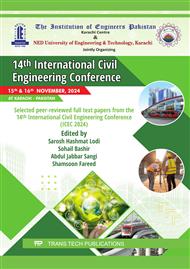p.181
p.191
p.205
p.213
p.223
p.233
p.241
p.249
p.255
Effect of Shallow Foundation Size on Bearing Capacity of layered Soil: 3D Numerical Simulations
Abstract:
The depth of the induced stresses of a rigid foundation known as significant depth, is related to the width of the foundation. The conventional bearing capacity equations can lead to significant inaccuracies if the top layer thickness is less than the significant depth of the foundation. In this study, series of 3D numerical simulation analysis on various sizes of foundation are performed. Two different soil profiles with same top layer underlain by, a) harder soil layers (Soil Profile A) and, b) weaker soil layers (Soil Profile B), were used in this study. The settlement profile showed that the settlement occurred to greater depth in soil profile B. The bearing capacity decreased significantly with increased foundation size. The bearing capacity was decreased by 85% from 108 to 16 kN/m2, and by 93% from 97 to 7 kN/m2 for foundation size of 2m×2m and 20m×20m in soil profile A, and B, respectively. The soil layers effect was more significant for large foundation size where the bearing capacity was decreased by 10 and 57 % in soil profile B for 2m×2m and 20m×20m foundation sizes respectively. The study emphasizes the need of incorporating the soil proper up to depth equal two times the foundation size.
Info:
Periodical:
Pages:
249-254
Citation:
Online since:
April 2025
Authors:
Keywords:
Price:
Сopyright:
© 2025 Trans Tech Publications Ltd. All Rights Reserved
Share:
Citation:


